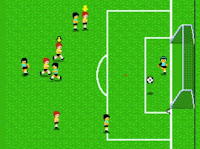Shoot! magazine's 'Focus' feature is legendary. Essentially an interview with a football player using the same basic questions every week, it often provided an interesting insight into their life and interests.
All very honourable on the part of Shoot! but what about us football fans? More to the point, what about the thousands of bloggers and podcasters that truly make the world of football go round these days? Shouldn't they be celebrated for their achievements too?
Here at The Football Attic, we decided it was time to answer that question in the positive, so we created a regular 'Focus' feature of our own called 'Focus On...' - and you're invited to be a part of it!
If you're a football blogger or podcaster, here's what to do. Simply go to our feedback form, fill in as many or as few of the boxes as you like, send us a picture of yourself and with any luck you'll be appearing here on The Football Attic's 'Focus On' feature at some point in the not too distant future!
When it comes to answering the questions on our form, please ensure that your answers aren't too lengthy or too heavily reliant on obscene language! Similarly, when you reach the question 'Favourite Food', we realise it will be tempting to type 'Steak and chips' in an ironic 'retro' sort of way, but please refrain from doing so unless it really is your favourite food! Finally, please be aware that we may edit some of your text for brevity or to correct spelling/grammar where necessary. We'll try not to, but sometimes it might be unavoidably necessary.
As you can see from the image above, a key part of the old 'Focus' feature was a picture of the player being interviewed, so in order to remain true to the tradition, we'd like you to send us a picture of yourself once you've filled out the feedback form (not necessarily in full kit, you'll be pleased to hear). Please email your photo to admin [at] thefootballattic [dot] com and we'll do the rest.
So there you go - football bloggers and podcasters, now's the chance to find out more about your peers... but it'll only happen if you step forward and take part!
Many thanks in advance for your participation in this fun little project of ours. With your help, we're sure you'll help us make it a great success!
Best wishes, Chris and Rich.
Fill out our feedback form here >>>
All very honourable on the part of Shoot! but what about us football fans? More to the point, what about the thousands of bloggers and podcasters that truly make the world of football go round these days? Shouldn't they be celebrated for their achievements too?
Here at The Football Attic, we decided it was time to answer that question in the positive, so we created a regular 'Focus' feature of our own called 'Focus On...' - and you're invited to be a part of it!
If you're a football blogger or podcaster, here's what to do. Simply go to our feedback form, fill in as many or as few of the boxes as you like, send us a picture of yourself and with any luck you'll be appearing here on The Football Attic's 'Focus On' feature at some point in the not too distant future!
When it comes to answering the questions on our form, please ensure that your answers aren't too lengthy or too heavily reliant on obscene language! Similarly, when you reach the question 'Favourite Food', we realise it will be tempting to type 'Steak and chips' in an ironic 'retro' sort of way, but please refrain from doing so unless it really is your favourite food! Finally, please be aware that we may edit some of your text for brevity or to correct spelling/grammar where necessary. We'll try not to, but sometimes it might be unavoidably necessary.
As you can see from the image above, a key part of the old 'Focus' feature was a picture of the player being interviewed, so in order to remain true to the tradition, we'd like you to send us a picture of yourself once you've filled out the feedback form (not necessarily in full kit, you'll be pleased to hear). Please email your photo to admin [at] thefootballattic [dot] com and we'll do the rest.
So there you go - football bloggers and podcasters, now's the chance to find out more about your peers... but it'll only happen if you step forward and take part!
Many thanks in advance for your participation in this fun little project of ours. With your help, we're sure you'll help us make it a great success!
Best wishes, Chris and Rich.
Fill out our feedback form here >>>


























































